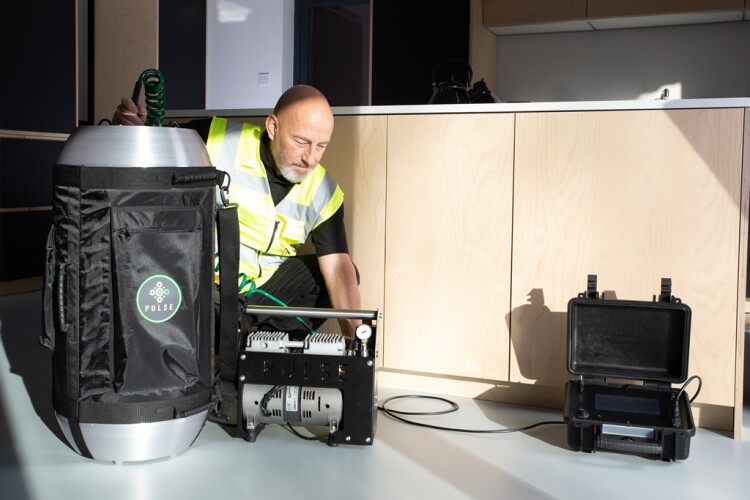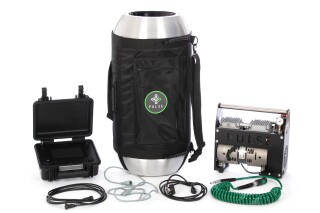The low-pressure Pulse test is now an approved alternative method to the standard blower door test to measure the air tightness of buildings.
Pulse is a portable compressed-air based system that is used to measure the air leakage of a building or enclosure at a near ambient pressure level (4Pa). By measuring at a lower pressure, the system provides an air change rate measurement that is representative of normal inhabited conditions, helping to improve understanding of energy performance and true building ventilation needs.
The full Pulse system comprises of an air receiver and nozzle unit, an air compressor and a touch screen control module. The testing unit is self-contained and has no need to penetrate the building fabric or block up any doorways, so there is minimal disruption to construction work or building occupants.
The technology was developed by The University of Nottingham, and is now commercially-licensed to tech start-up, Build Test Solutions (BTS).
“After many years in development it is fantastic to see our research translated into a product not only fit-for-industry, but that has ministerial approval for use under the UK building regulations,” said Chris Wood, one of the research team at the university. “The tool has massive potential to support the government’s plans to deliver a sustainable, low-carbon built environment.”
Following a public consultation on its Future Homes Standard (proposed changes to both Parts L (energy) and F (ventilation) of existing building regulations), the Ministry of Housing confirmed that:

- All new dwellings should have an air tightness test (effectively removing the existing sampling approach)
- Pulse technology, under Part L1a, is an accepted alternative method of air tightness testing, including for use in very air tight dwellings.
Luke Smith, managing director of Build Test Solutions said: “We are delighted with this outcome, which is testament to the extensive field trial testing, product development and third-party validation that has taken place over the years. It has been quite the journey but to reach this milestone and see the positive responses made by so many industry respondents is fantastic.
“We firmly believe that Pulse delivers a pioneering approach to fabric air permeability measurement; not only allowing the industry to more readily step up to the new requirement for 100 per cent sample testing but perhaps most importantly of all, providing greater choice to clients and testers alike.”
The Pulse test is placed centrally in a dwelling and a burst of air is released over a 1.5 second period. The background pressure is sampled at high frequency and the signature that the burst of air creates provides a representation of the air leakage characteristics of the property under test.
Pulse is a complimentary technique to the existing blower door fan pressurisation method rather than a direct replacement, its developers say . It offers a solution for providing new metrics as well as an improved means of testing other types of buildings and enclosures such as existing homes, non-residential buildings (through tethering of multiple Pulse devices), laboratories, health care environments and gaseous fire suppression facilities such as data centres, server rooms and stores.
Development of the Pulse technology was supported by the Engineering and Physical Sciences Research Council (EPSRC) Impact Acceleration Accounts fund.
Got a story? Email news@theconstructionindex.co.uk




